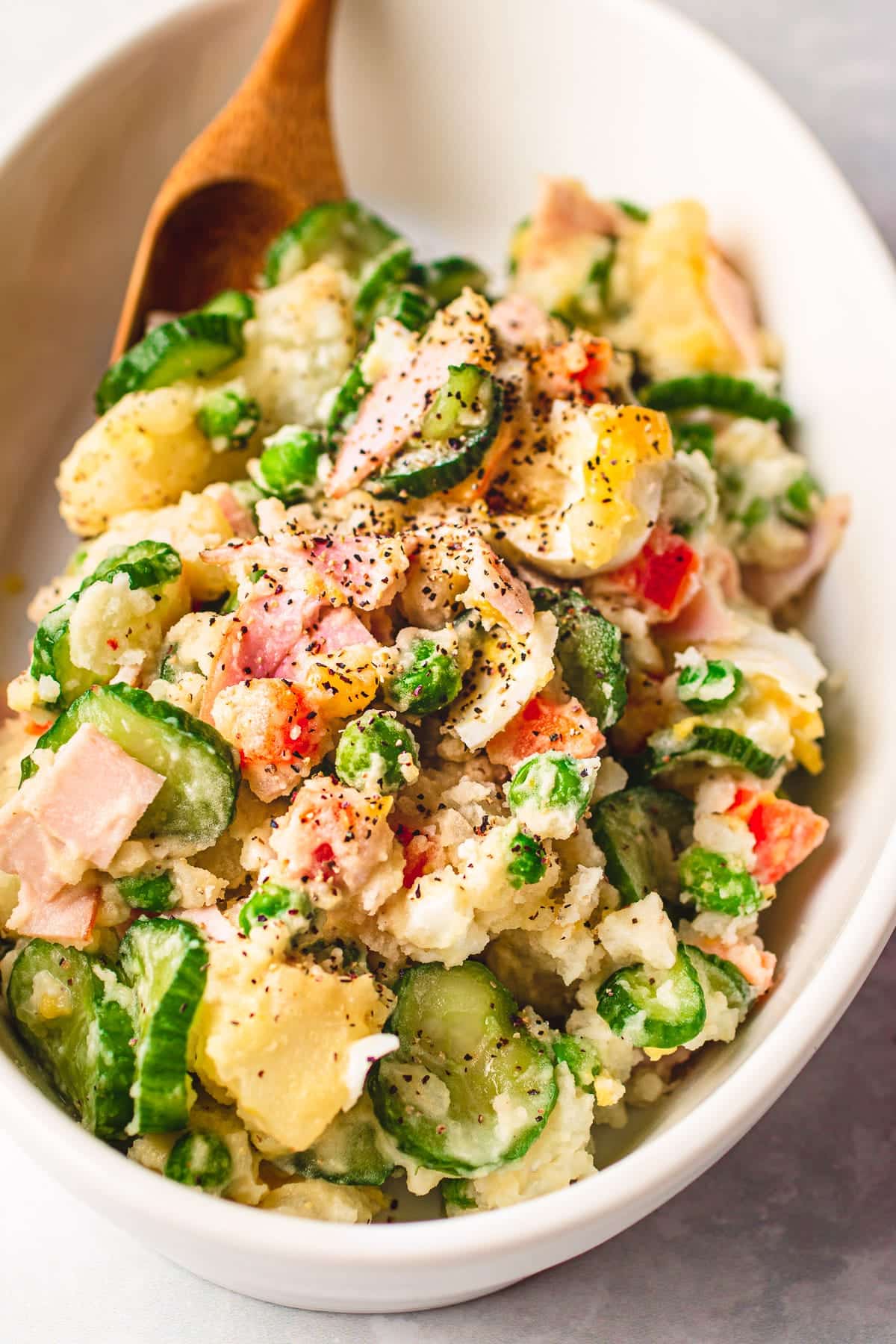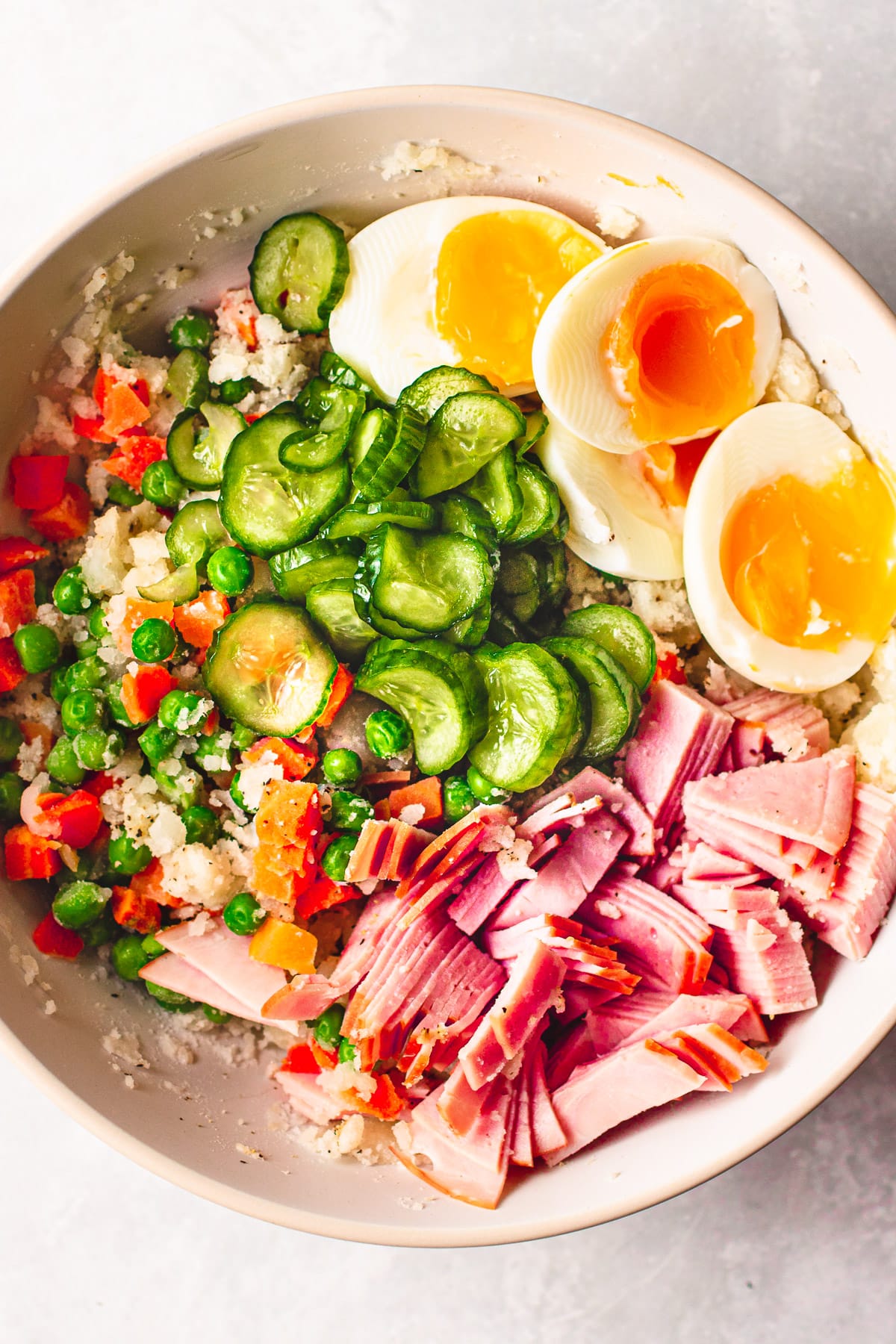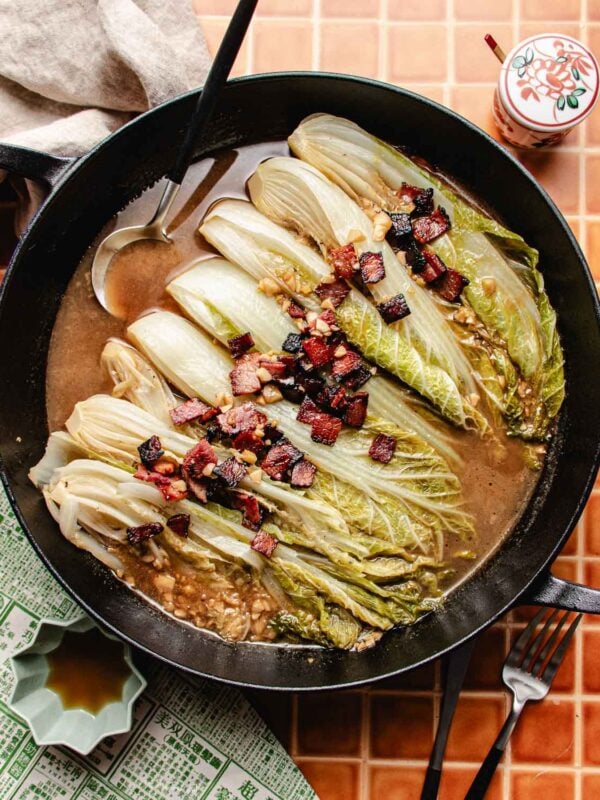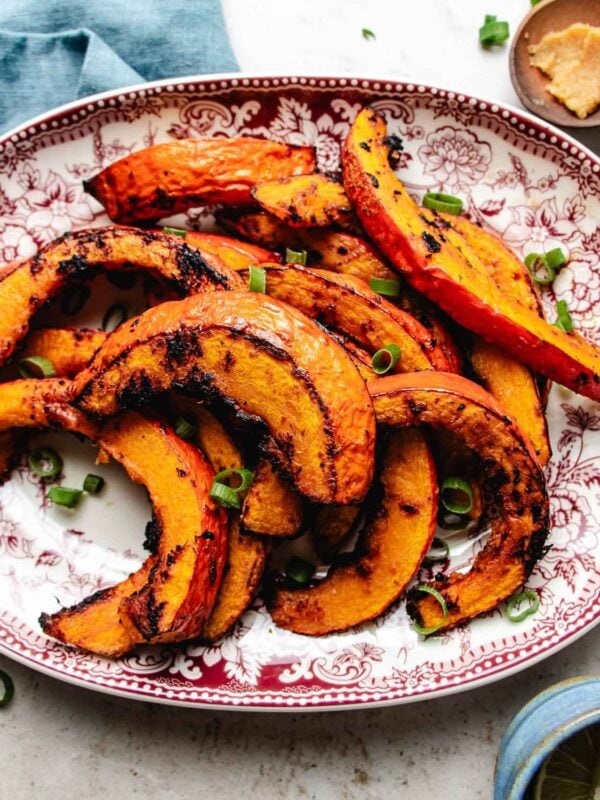This post may contain affiliate links. Please read our disclosure policy.
This Japanese potato salad is a veggie-packed side dish perfect for outdoor BBQs and potlucks! Easy to make, delicious, and naturally gluten-free, this traditional Japanese salad features crunchy vegetables, salty bits of ham, and jammy eggs in a light yet creamy kewpie mayo dressing.
One of the most popular of all Japanese potato dishes, potato salad is a Yoshoku—or Western-inspired—dish. This is comfort food to the max and has major summertime vibes. Enjoy it with a glass of cold beer!

Table of Contents
What is Japanese potato salad?
Japanese style potato salad, known as “potesara,” is a delightful twist on a classic dish, blending the comfort of Western-style potato salads with unique Japanese flavors.
Part of Yoshoku cuisine—a fascinating category that includes Western-influenced dishes adapted since the late 1800s—this salad has evolved to captivate Japanese palates.
Unlike traditional European or American potato salads, the Japanese version includes ingredients like cucumber, carrots, and a creamy Japanese mayonnaise, made with egg yolk, rice vinegar, and dashi, giving it a refreshing edge.
It’s commonly served alongside fried foods or as a side in bars, adding a creamy contrast to crispier dishes. My recipes for Japanese hamburger steak and Paleo chicken katsu are other yummy examples of Yoshoku dishes that you might enjoy!
Ingredients
This tasty Asian potato salad builds great texture and depth using a few, flavorful ingredients that can easily be found at local Western grocery stores. Along with creamy potatoes and crunchy veggies, Japanese kewpie mayo is a star of the show bringing umami and tanginess to the table.

For the potato salad:
- Mini cucumbers: Persian cucumbers or English cucumbers work well because they are seedless, have less moisture, and have a thin skin.
- Potatoes: Starchier potatoes like Russet or Yukon Gold have the best texture.
- Coarse sea salt and ground black pepper
- Boiled eggs: A traditional ingredient that adds extra creaminess and protein to the dish.
- Veggies: Use frozen veggies for easy prep. I like peas and carrots, but corn and green beans work well too.
- Diced sandwich ham: Adds saltiness and extra protein.
- Chopped scallions
For the salad dressing:
- Kewpie mayo: Japanese mayonnaise made with egg yokes and tangy vinegar. See below for more info.
- Rice vinegar: Adds a sweet-tangy flavor to the dish.
- Shiitake mushroom seasoning: Or use dashi powder. These serve as a natural MSG alternative for added depth of flavor. See below for more alternatives.
Tip: For variety, try adding canned tuna, chopped apples, blanched broccoli florets or green beans, and sweet corn to the salad mix.
Japanese mayonnaise (Kewpie mayo)
Unlike typical mayonnaises, Japanese mayonnaise, or Kewpie, has no added sugar and relies on a unique blend of ingredients — egg yolk, rice vinegar, oil, dashi powder (natural msg), and spice blends —to bring natural sweetness and tang.
The richness comes from exclusively using egg yolks, not whole eggs.
Don’t Have Japanese Mayo? No worries! Enhance regular mayo with a pinch of salt, pepper, and rice vinegar. Add a sprinkle of dashi powder (Hondashi) or Shiitake mushroom seasoning (Takii) for extra umami. A quarter teaspoon of MSG can also mimic Kewpie’s unique flavor if you’re open to it.
Tip: Not all mushroom seasonings are created equal! Check ingredients first, as some mixes are enhanced with Western herbs, which can alter the flavor profile of Asian dishes. Stay tuned for my upcoming post on choosing the best mushroom seasoning for authentic flavors!
How to make Japanese potato salad
This Oriental kewpie mayo potato salad is speedy to whip up after a bit of prep work. You can prepare things ahead by cooking the potatoes and dicing veggies in advance. Remember that this Japanese potato dish is best served chilled after the flavors have had time to build.


- Salt the cucumber: Thinly slice the cucumbers and add them to a mixing bowl with salt. Use your hands to rub in the salt and set the bowl aside. This will pull out excess moisture.


- Cook the potatoes: Peel them and cut them into small chunks. Immediately place them into a large pot and cover them with cold water and salt. Cook until fork tender, about 10 minutes.
- Drain and season: Drain the cooked potatoes well then transfer to a large heat-proof mixing bowl. Season with salt and pepper and roughly mash, leaving some chunks for texture.
- Eggs and veggies: In a separate saucepan, cook the eggs for 7-8 minutes. Remove the eggs and blanch the carrots and peas until tender, about 10 seconds. Set them aside to cool.
- Make the dressing: In a measuring cup with a spout, combine the mayo with vinegar and mushroom seasoning.
- Assemble: Add the eggs and lightly mash them. Squeeze the cucumbers to remove the excess liquid then add to the bowl with peas and carrots. Finally, add the ham and scallions and mix in the dressing, starting with half. Taste and adjust as needed.
- Serve: You can serve it at room temperature, but it’s best served chilled. It tastes the best when chilled. After mixing, let it cool in the fridge for at least a few hours or overnight.
Tip: Dicing the potatoes to similar sizes and adding them to the cooking water while it’s still cold will help the potatoes cook evenly from the inside out.

What type of potatoes to use
For the perfect Japanese mashed potatoes, opt for Yukon Gold or Russet potatoes. These varieties are ideal thanks to their starchy and creamy texture. They have a light and creamy mouthfeel similar to that of Japanese sweet potatoes, which are used in the popular Japanese sweet potato salad.
Roughly mashing these potatoes creates a delightful texture contrast that complements the colorful, crunchy veggies in the salad. Not only is the dish a feast for the eyes, but it’s also delicious enough to enjoy on its own—even the next day!
Make ahead and store
- Make ahead: This is a great make-ahead dish! It’s best served chilled for at least a few hours, which allows the flavors to build. You can prepare this recipe up to 2 days before serving.
- Storage: Store leftovers in an airtight container in the refrigerator for up to 3 days (if it lasts that long!) Enjoy cold on its own, as a side dish, or even as a potato salad sandwich!
What to serve it with
This tasty potato salad Japanese dish is a perfect accompaniment to any summertime BBQ or potluck spread! Enjoy it on its own or serve it alongside your favorite grilled proteins, salads, and grains. Enjoy it with your favorite cocktail or summertime drink!
- Proteins: This salad goes great with my air fryer teriyaki salmon. Or serve it with Japanese Tsukune (juicy chicken meatballs), tomato pasta shrimp, or Temaki sushi with canned tuna.
- More Japanese sides: Pair with this summery Gomaae Japanese spinach salad with sesame dressing, low-carb shirataki noodles with peanut sauce, or crispy rice sushi with salmon.
- Cocktail: Keep the summertime vibes alive with elegant and refreshing sake grapefruit cocktail or Strawberry lemonade vodka.
Umami Tips
- Salt the Cucumbers: Begin by salting the slices of Persian or English cucumbers to draw out excess moisture.
- Choose the Right Potatoes: Opt for Russet or Yukon Gold potatoes for their creamy and fluffy texture. They hold their shape well yet are easy to mash slightly for that ideal texture.
- Monitor Potato Cooking: Boil the potatoes until just fork-tender. Overcooking can make them too mushy, while undercooking will leave them too hard for the salad. Aim for a balance where they are easy to mash but still retain some chunks for texture.
- Cool Ingredients Before Adding Mayo: Allow the boiled eggs, potatoes, and blanched veggies to cool down before adding the mayo. Combining these ingredients while they are still hot can cause the mayo to become oily and separate,
- Adjust Dressing to Taste: Start with half the amount of dressing and add more as needed. This allows you to control the creaminess and flavor intensity without making the salad too soggy.
- Serve Chilled: For the best flavor, chill the salad before serving. This allows the flavors to meld together beautifully, enhancing the overall taste.
- Substitute for Kewpie Mayo: If you don’t have Kewpie mayonnaise, you can achieve a similar flavor by seasoning regular mayonnaise with a small dash of rice vinegar and a sprinkle of MSG, if you’re not averse to it. Dashi powder or Asian shiitake or kombu made mushroom seasoning works great, too.
FAQs
Japanese mayo uses only egg yolks, a unique vinegar blend, and often includes umami-rich ingredients like dashi, giving it a richer, creamier, and tangier profile than regular mayo
Season the regular mayo with a small dash of rice vinegar and sprinkle a touch of shiitake mushroom seasoning such as Takii umami powder or Dashi powder (such as Hondashi).
For a vegetarian version, simply omit the ham or substitute it with a vegetarian protein like cooked and seasoned tofu or tempeh.
This salad tastes best when chilled for a few hours in the refrigerator before serving. This resting period allows the flavors to develop fully.
More gluten-free Japanese recipes
If you enjoyed this Japanese potato dish, give some of my other Japanese-inspired recipes a try, too!
- Oyako donburi is a Japanese chicken, egg, and rice bowl with caramelized onions.
- Japanese cucumber salad with spiralized cucumbers and a toasted sesame dressing.
- Omurice rice omelet made with low-carb shirataki rice.

Japanese potato salad recipe

Video
Ingredients
For the Japanese potato salad:
- 16 oz. Yukon gold or Russet potatoes
- 1 ¼ tsp coarse sea salt divided
- 2-3 large boiled eggs
- 3 whole mini cucumbers 6 oz. total, Persian or English cucumber
- ¼ tsp ground black pepper
- 1 cup frozen carrots and peas
- 4 pieces sandwich ham diced
- 2 bulb scallions chopped, optional
For the salad dressing:
- 5 tbsp Kewpie mayonnaise see notes
- 1 tbsp rice vinegar
- ¼ to ½ tsp Takii mushroom seasoning or dashi powder (see notes)
Instructions
- Potatoes: Peel the potatoes and cut them into similar sizes, about ¾-inch chunks. Immediately place them into a large pot and add cold water to cover by 1 inch above. Sprinkle in a pinch of salt.
- Cover the pot with a lid, leaving a small gap to avoid boiling over. Bring the water to boil over medium-high heat then reduce heat to medium, and simmer. Stir a few times, until potatoes are fork tender, about 10 minutes.
- Eggs: In a separate saucepan bring the water to boil then reduce heat to medium-low, add the eggs and simmer for 7-8 minutes. Remove the eggs and blanch the carrots and peas until tender, about 10 seconds. Set them aside to cool.
- Cucumber: While the potatoes and the eggs are boiling, thinly slice the cucumbers. Add them to a mixing bowl with 1 tsp salt. Use your hands to gently rub the salt into the cucumber slices. Set the bowl aside.
- Season: Drain the potatoes then transfer to a large heat-proof mixing bowl. Season with ¼ tsp salt and pepper. Use a potato masher to roughly mash, leaving some chunky for texture. While the potato is still hot, add the frozen vegetables. Gently toss to mix.
- Mayo: In a measuring cup with spout, combine the mayo with vinegar and mushroom seasoning. Chill it in the fridge while you gather other ingredients ready.
- Assemble: Peel the eggs and add to the potato bowl. Lightly mash them together. Squeeze the cucumbers to remove the excess liquid then add to the bowl. Finally add the ham and scallions.
- Pour in the dressing, starting with half amount. Gently toss to incorporate. Taste and adjust with more dressing, if needed. A touch more salt and pepper might help bring the flavor together.
- Serve: You can serve the potato salad at room temperature however it tastes the best when chilled. Ideally, I like to cover the salad bowl and refrigerate for a few hours to allow the flavor to truly develop before serving.
Notes
- Can I make ahead? This potato salad with egg can be prepared and assembled up to 2 days before serving.
- How long does potato salad last? I recommend finishing the salad within 2-3 days but it rarely lasts that long! The sweet, tangy, and creamy flavor really make this dish excellent. It’ll be gone before you know it! 🙂
- Serve chilled: It tastes even better when it’s chilled so give it some time to allow the flavors meld. If I’m planning to serve in the evening, I’ll prepare it at lunch so it can sit and build the flavors.
- No Japanese mayo or Mushroom seasoning? Season the regular mayo with a small dash of rice vinegar and vegetable bouillon powder. If you’re open to it, a quarter teaspoon of MSG can also simulate that distinctive umami. And for next time, consider snagging a bottle of real Kewpie mayo!
- Tip: Not all mushroom seasonings are created equal! Check ingredients first, as some mixes are enhanced with Western herbs, which can alter the flavor profile of Asian dishes. Stay tuned for my upcoming post on choosing the best mushroom seasoning for authentic flavors!
Nutrition
Nutrition information is automatically calculated, so should only be used as an approximation.
Made a dish and loved it? Please rate the recipe and leave a comment in the section below! It helps my blog grow organically, allowing me to continue sharing free and awesome content with you. Thank you!













This recipe was so easy. My kids loved it. it’s going to be my new go to.